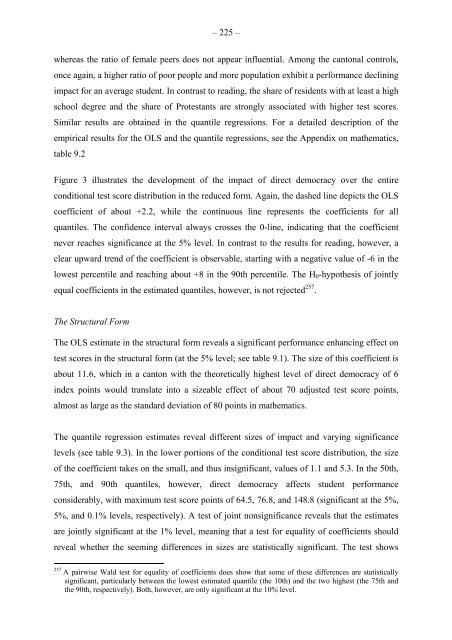The Impact of Direct Democracy on Society - Universität St.Gallen
The Impact of Direct Democracy on Society - Universität St.Gallen
The Impact of Direct Democracy on Society - Universität St.Gallen
- No tags were found...
You also want an ePaper? Increase the reach of your titles
YUMPU automatically turns print PDFs into web optimized ePapers that Google loves.
– 225 –whereas the ratio <str<strong>on</strong>g>of</str<strong>on</strong>g> female peers does not appear influential. Am<strong>on</strong>g the cant<strong>on</strong>al c<strong>on</strong>trols,<strong>on</strong>ce again, a higher ratio <str<strong>on</strong>g>of</str<strong>on</strong>g> poor people and more populati<strong>on</strong> exhibit a performance decliningimpact for an average student. In c<strong>on</strong>trast to reading, the share <str<strong>on</strong>g>of</str<strong>on</strong>g> residents with at least a highschool degree and the share <str<strong>on</strong>g>of</str<strong>on</strong>g> Protestants are str<strong>on</strong>gly associated with higher test scores.Similar results are obtained in the quantile regressi<strong>on</strong>s. For a detailed descripti<strong>on</strong> <str<strong>on</strong>g>of</str<strong>on</strong>g> theempirical results for the OLS and the quantile regressi<strong>on</strong>s, see the Appendix <strong>on</strong> mathematics,table 9.2Figure 3 illustrates the development <str<strong>on</strong>g>of</str<strong>on</strong>g> the impact <str<strong>on</strong>g>of</str<strong>on</strong>g> direct democracy over the entirec<strong>on</strong>diti<strong>on</strong>al test score distributi<strong>on</strong> in the reduced form. Again, the dashed line depicts the OLScoefficient <str<strong>on</strong>g>of</str<strong>on</strong>g> about +2.2, while the c<strong>on</strong>tinuous line represents the coefficients for allquantiles. <str<strong>on</strong>g>The</str<strong>on</strong>g> c<strong>on</strong>fidence interval always crosses the 0-line, indicating that the coefficientnever reaches significance at the 5% level. In c<strong>on</strong>trast to the results for reading, however, aclear upward trend <str<strong>on</strong>g>of</str<strong>on</strong>g> the coefficient is observable, starting with a negative value <str<strong>on</strong>g>of</str<strong>on</strong>g> -6 in thelowest percentile and reaching about +8 in the 90th percentile. <str<strong>on</strong>g>The</str<strong>on</strong>g> H 0 -hypothesis <str<strong>on</strong>g>of</str<strong>on</strong>g> jointlyequal coefficients in the estimated quantiles, however, is not rejected 257 .<str<strong>on</strong>g>The</str<strong>on</strong>g> <strong>St</strong>ructural Form<str<strong>on</strong>g>The</str<strong>on</strong>g> OLS estimate in the structural form reveals a significant performance enhancing effect <strong>on</strong>test scores in the structural form (at the 5% level; see table 9.1). <str<strong>on</strong>g>The</str<strong>on</strong>g> size <str<strong>on</strong>g>of</str<strong>on</strong>g> this coefficient isabout 11.6, which in a cant<strong>on</strong> with the theoretically highest level <str<strong>on</strong>g>of</str<strong>on</strong>g> direct democracy <str<strong>on</strong>g>of</str<strong>on</strong>g> 6index points would translate into a sizeable effect <str<strong>on</strong>g>of</str<strong>on</strong>g> about 70 adjusted test score points,almost as large as the standard deviati<strong>on</strong> <str<strong>on</strong>g>of</str<strong>on</strong>g> 80 points in mathematics.<str<strong>on</strong>g>The</str<strong>on</strong>g> quantile regressi<strong>on</strong> estimates reveal different sizes <str<strong>on</strong>g>of</str<strong>on</strong>g> impact and varying significancelevels (see table 9.3). In the lower porti<strong>on</strong>s <str<strong>on</strong>g>of</str<strong>on</strong>g> the c<strong>on</strong>diti<strong>on</strong>al test score distributi<strong>on</strong>, the size<str<strong>on</strong>g>of</str<strong>on</strong>g> the coefficient takes <strong>on</strong> the small, and thus insignificant, values <str<strong>on</strong>g>of</str<strong>on</strong>g> 1.1 and 5.3. In the 50th,75th, and 90th quantiles, however, direct democracy affects student performancec<strong>on</strong>siderably, with maximum test score points <str<strong>on</strong>g>of</str<strong>on</strong>g> 64.5, 76.8, and 148.8 (significant at the 5%,5%, and 0.1% levels, respectively). A test <str<strong>on</strong>g>of</str<strong>on</strong>g> joint n<strong>on</strong>significance reveals that the estimatesare jointly significant at the 1% level, meaning that a test for equality <str<strong>on</strong>g>of</str<strong>on</strong>g> coefficients shouldreveal whether the seeming differences in sizes are statistically significant. <str<strong>on</strong>g>The</str<strong>on</strong>g> test shows257 A pairwise Wald test for equality <str<strong>on</strong>g>of</str<strong>on</strong>g> coefficients does show that some <str<strong>on</strong>g>of</str<strong>on</strong>g> these differences are statisticallysignificant, particularly between the lowest estimated quantile (the 10th) and the two highest (the 75th andthe 90th, respectively). Both, however, are <strong>on</strong>ly significant at the 10% level.
















